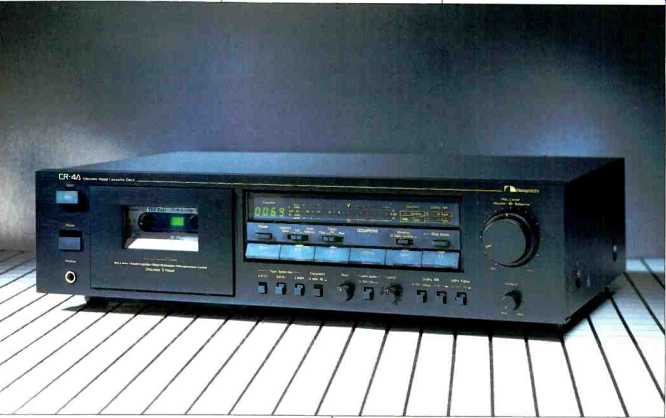
Manufacturer's Specifications:
Frequency Response: 20 Hz to 21 kHz, ±3 dB.
THD: Type IV tape, 0.8%; Types I and II tape, 1%.
S/N Ratio: 66 dBA with Dolby B NR, 72 dBA with Dolby C NR.
Separation: 37 dB at 1 kHz.
Crosstalk: 60 dB at 1 kHz.
Erasure: 60 dB at 100 Hz.
Input Sensitivity: 50 mV.
Output Level: Line, 500 mV; headphone, 5 mW into 8 ohms.
Wow & Flutter: 0.027% wtd. rms, ± 0.048% wtd. peak.
Fast Wind Time: 80 S for C-60 cassette.
Dimensions: 16 15/16 in. W x 31 5/16 in.
H x 1016 in. D (430 mm x 100 mm x 265 mm).
Weight: 13 lbs. (5.9 kg).
Price: $995.
Company Address: 19701 South Vermont Ave., Torrance, Cal. 90502.
Nakamichi's CR-4A deck features their discrete three -head recording system. The manufacturer emphasizes that this configuration-with physically separate record and playback heads-offers a number of advantages. Among them are the ability to align each head gap individually for the best magnetic performance, and superior isolation between record and playback. Nakamichi also states the design gets more accurate results from the deck's manual bias and calibration system. The transport is an asymmetrical dual-capstan design for minimum wow and flutter.
Both Dolby B and C NR are included, with an MPX filter that can be defeated for more extended high-frequency response. The CR-4A provides a manual change of equalization; use of 70-µS EQ with Type I tapes will reduce noise, while using 120-uS EQ with Types II and IV will increase high-frequency headroom.
Control Layout
The front panel has the typical Nakamichi look, light-gold lettering on a black background. The combination of colors gives good legibility over a wide range of lighting levels. The eject button is at the upper left of the panel, with the power on/off button and the gold-plated headphone jack below.
The cassette compartment door opens smoothly with a push of "Eject." Access for cleaning and demagnetization is fair, becoming excellent with the removal of the cover. A push of the play button will move the head assembly up and start the dual capstans driving the pinch rollers even if no tape is in place. This can be helpful in cleaning the tape path, but caution is needed to ensure that nothing gets caught between a capstan and a pinch roller.
The cassette carrier is not as rugged as it might be, but its metal and plastic frame is more rigid and more accurate than the typical all-plastic ones. When the door is pushed closed, the supply hub spins in the rewind direction to remove any tape slack. If the tape is already snug, there is substantially no motion to affect cueing. A light in the compartment makes it easy to see the status of the tape pack.
The head assembly is well constructed, and there are some eye-catchers in the tape compartment, too: Nakamichi tape guides, the pressure-pad lifter, and the matte finish of the capstans for better tape gripping. I would be remiss if I didn't mention the accessibility and extent of the head assembly adjustments, although I'm not encouraging users to fool with them. Too many decks cannot be adjusted easily for best performance, even by service technicians.
To the right of the tape compartment, along the top, is the display panel. On the left is the green-LED, four-digit counter, and to its right, the green-LED horizontal peak-responding meters, with 13 segments for each channel. The normal scale, which is between the channel-level displays, extends from-40 to + 10 dB, a fairly broad range. I found the gold-colored numbers easy to read up to -5, but the red numbers for 0 and above were a bit obscure.
In "Calibration" mode, the meter scales are expanded, as indicated by small numbers reading from-10 to + 5, with " Cal" at meter zero. The top LED display, normally for the left channel, is used for "Bias"; the bottom one, normally for the right, indicates "Level." (A discussion of calibration procedure will follow.) To the right of the meter display are four small, green status indicators for "Monitor" ("Source" and "Tape") and "Dolby NR" ("B-Type" and "C-Type"). Below the display panel, from left to right, are the counter reset button and three-position switches for the tape counter memory and for operation with an external timer.
The "Memory" switch selects "Memory Stop" at 0000, "Off," or "Auto Repeat" (which rewinds from the tape's end to counter zero and then replays until the function is turned off). The "Timer" switch selects "Play," "Off," or "Rec." Next on the right is the "Monitor" ("Tape/Source") push button and the momentary-contact "Rec Mute" button with its red-LED indicator. This button must be held in as long as muting is desired; the CR-4A does not automatically mute for a period of 4 S, then stop the tape, as many other decks do. It is true that this Nakamichi deck does not have a search mode to stop fast-winding when it detects such 4-S spaces, but its automatically timed muting is very helpful for spacing a series of selections as well as for making tapes to play on decks which do have search modes.
Below the buttons and switches are the large, angled transport buttons. From the left are rewind, stop, play, fast forward, pause, and record, each of which has a large function symbol on its face Stop, play, and pause also have good-size green LEDs inset into their top edges, and record has a similar indicator in red. It is possible to switch directly between play and the fast-wind modes without pressing the stop button, but the deck will stop itself very briefly for the transport cam to do its work. Record mode, however, can only be entered from stop mode; it is not possible to go into record from either pause or play, though that would certainly be helpful to some users. A push of the record button puts the CR-4A into record-pause mode; pushing the play button then initiates recording.
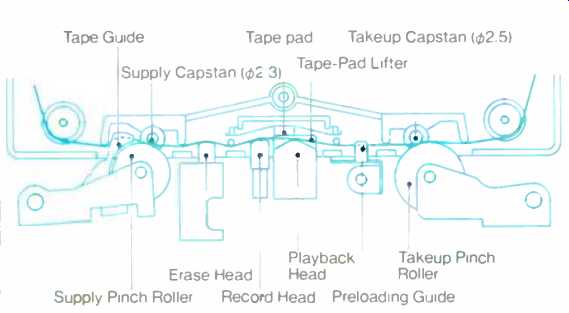
The transport features dual capstans, three discrete heads,
and a tape-pad lifter.

Multiple adjustments allow service technicians to tweak
the CR-4A's head alignment with extreme precision.
Below the transport buttons are eight pushbutton switches and two knobs. To the left are the interlocked "Tape Selector" (bias) buttons for "EX(I)," "SX(II)," and "ZX(IV)." I'm a little surprised to see that manual bias selection is required, but the inclusion of the "EQ(µSec)" switch (next on the right), with its choice of "120/70," is consistent with the manual bias switching. There are advantages in being able to select equalization for the best overall results with the music being recorded. I would have liked, however, to have a red indicator go on whenever the EQ choice was not the normal one for the tape type in use.
To the right of the EQ switch are the "Calibration" pots "Bias" to the left, "Level" to the right, and an "Off/On" button in the center. (A small red LED indicates "On," which is very important since it is impossible to record while in calibration mode.) The pots have definite center detents, perhaps slightly too stiff. The knobs are somewhat small and have smooth surfaces; a larger size or some light knurling would make them easier to turn.
Calibration is started by going into record-pause mode, resetting the counter to zero, and turning on "Calibration." (Dolby NR should be off.) Pushing the play button starts the actual recording of the deck's two test signals. The average 15-kHz level for the two channels is shown on the top ("Bias") meter, and 400-Hz on the bottom ("Level") meter.
As mentioned earlier, these meter scales are expanded to facilitate making accurate adjustments. The position of the "Monitor" switch has no effect on the display: In calibration mode, playback is always shown. First, bias is adjusted to make indications for the upper and lower meters the same.
Then, level is adjusted so the lower display matches " Cal." If necessary, bias is readjusted to get the upper indication exactly to the " Cal" mark. Finally, turning off "Calibration" triggers an automatic rewind to counter zero in preparation for actual recording.
To the right of the calibration controls are pushbutton switches for "Dolby NR" ("Off/On" and "B/C") and "MPX Filter." All front-panel button switches have a good feel, but their status is a bit hard to see in dim light because the controls are the same color as the panel.
Furthest to the right along the bottom is the "Output" level control-always a good thing to include, in my view. Above it are concentric, large-knobbed "Master" and "Balance" recording-level controls. The "Balance" ring, which is larger and to the rear, has a nice, soft center detent. This control functions by attenuating the channel opposite the direction in which it is turned: Turning the knob to the left, for example, lowers the level in the right channel. I expect that its use would become quite natural after awhile.
The back panel has the expected stereo in/out phono jacks, which have nice gold-plating. Also on this panel is a system-remote DIN-type socket which can be connected to either the RM-5 wired remote or to other Nakamichi components equipped for system remote operation.
I got a look inside the CR-4A by removing its top and side cover. One large p.c. board covered about three-quarters of the chassis area. Two other boards were at a higher level: One held most of the power-supply components, and the other carried the meter and calibration circuits. A vertical board was behind the meters and controls, and several small boards were placed at various points.
Parts quality was high, and all were identified clearly with white lettering. Some of the boards were a bit springy, but in general they were well supported. The soldering was excellent, with substantially no flux-except at the hand-soldered points. Interconnections were made with multi-pin plugs and sockets, using either ribbon cable or bundled single wires.
The transport was fairly quiet in fast-wind and outstandingly quiet in play or record. The two flywheels, each driving a capstan, are of good size, which should aid smooth tape movement. The cam action appeared to be quick and efficient, and it certainly was quiet. I judged the general construction of the rotating elements and support structure to be rigid and reliable.
The power transformer, which was mounted on a side rail near the back panel, had a surrounding shield. After a period of use, the shield was just warm to the touch. A p.c. board on the rail next to the transformer provided clip -mounting for three fuses. The two side rails greatly helped to make the overall construction rigid. With the cover in place, it was even better.
Measurements
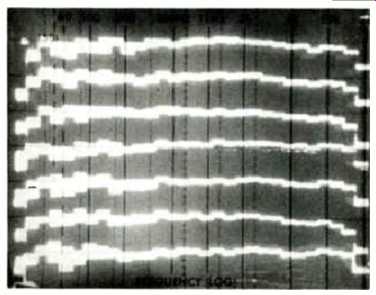
Fig. 1--Record/playback response to "PN/Music" test signal (see text),
recorded with Dolby C NR. Top three traces recorded at rms levels of +5 dB (+10
on CR-4A's meter), using Nakamichi EXII, SX, and ZX tapes, respectively, and
with bias- and level-calibration pots at center detents. Next three traces recorded
at rms levels of 0 dB (+7 on the meter), using the same tapes and calibration
settings. Bottom trace is for ZX tape, at an rms level of 0 dB, after slight
bias trim. (Vertical scale: 5 dB/div.)
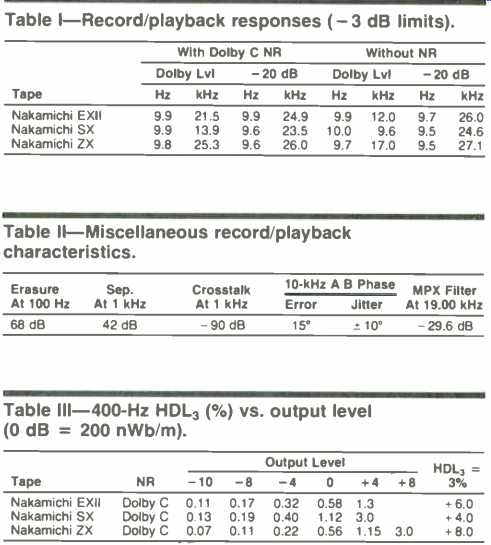
Table I--Record/playback responses (-3 dB limits).
Table II--Miscellaneous record/playback characteristics.
Table III--400-Hz HDL3 (%) vs. output level (0 dB = 200 nWb/m).
The playback responses with TDK (120-µS) and BASF (70-uS) calibration tapes were within ± 1.0 dB, relative to the level at 315 Hz, from 63 Hz to 12.5 kHz. There was some rise in responses at the lowest frequencies because of fringing from the full-width test tapes. There also was a rise in level at the highest frequencies with the Type II and IV tapes, reaching +2.7 dB at 18 kHz. The tape play speed was as accurate as I could measure, closer than ± 0.1%. Dolby play level indicated zero on the meter, as it was supposed to for the Nakamichi deck.
Quick checks in calibration mode showed that the level pot had a range from-3.4 to +2.6 dB at 400 Hz, and the bias-level control could adjust the 15-kHz level from -4 to +3 dB, both relative to the center-detent position with Nakamichi ZX (Type IV) tape. I needed a little calibration myself, as I had expected that rotating the bias pot to the right would increase bias and drop the 15-kHz level. Actually, rotating the pot to the right decreases the bias, which increases the 15-kHz level. Thus, the bias meter indication changes in the same direction as the pot is turned, just as the level indication does with its pot.
Nakamichi supplied samples of their EXII, SX, and ZX tapes, but I really wanted to see how well the manual-bias and level-calibration process would work with a wide variety of formulations. I made my tests using pink noise as the source, and switched on the deck's Dolby C NR, which emphasizes any response and level deviations. I had to roll -off the pink noise at 25 kHz to prevent in-band modulation; in the real world, there would be no energy this high, except perhaps with some wild synthesizer setting.
Calibrating the deck to each tape was a speedy process requiring just a few seconds-unless the tape was near the extremes of the deck's bias and/or sensitivity ranges. The CR-4A provided substantially exact matches, with very flat record/playback responses for 75 out of the 78 tapes I tried.
The minimum bias setting was too high for a Fuji ER (Type I) tape I had on hand, and there was a 3-dB peak at 20 kHz with the Type II Memorex CDX and Triad EM-X formulations.
This peak seemed to correspond to the one at 18 kHz which I measured in my playback-response tests, but these were the only two tapes which produced such obvious peaks.
Record/playback responses were measured with my latest version of "PN/Music," which is flat on a third-octave basis from 25 Hz to 2 kHz. It then rolls off to a shelf of -8 dB from 5 kHz to 16 kHz, with a further roll-off at 20 kHz. This frequency envelope is very close to that for the most challenging music. Compensating equalization was used on the deck's output, so my analyzer would show a flat display when response was flat, except for the drop at 20 kHz. Tests were made at rms levels of 0 dB (which made the peak -reading meter's + 7 LED flash) and 5 dB (which made the + 10 LED glow steadily). At the higher level, the results showed some occasional clipping of the highest peaks in the deck's output.
Figure 1 shows the record/playback responses; the traces for +5 dB are at the top (EXII, SX, and ZX, from the top down), followed by the three 0-dB responses in the same order. These traces all show response with the deck's calibration pots at their zero detents. The bottom trace shows response for ZX after I turned the bias pot slightly to the right to get exact calibration. All these responses are admirably flat, and the higher level responses demonstrate the value of Dolby C NR at the highest frequencies. Table I lists the-3 dB limits with a sine-wave test tone for the three tapes, with and without Dolby C NR, at Dolby level and at-20 dB. The value of Dolby C NR at higher levels is further demonstrated, and the reduction in the roll-off points at-20 dB with NR is minor indeed.
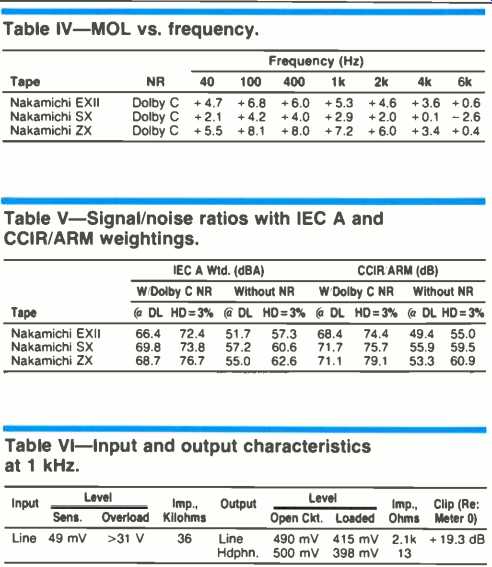
Table IV--MOL vs. frequency.
Table V--Signal/noise ratios with IEC A and CCIR/ARM weightings.
Table VI--Input and output characteristics at 1 kHz.
Except for the roll-offs at the frequency extremes, the record/playback responses at-20 dB for EXII and SX were flat within ±0.5 dB. The ZX response met the same limits, except for a sharp 2-dB peak at 22 kHz. The 10-Hz low -frequency limits are typical for a Nakamichi deck but quite unusual in general. The lowest frequencies of most music, of course, are octaves higher than this, but the CR-4A's 10-Hz response allows recording the lowest organ tones and reduces distortion at higher frequencies as well.
Bias in the output during recording was very low. Table II lists some miscellaneous record/playback test results. The 68-dB erasure of ZX metal tape at 100 Hz is excellent, one of the best I have ever measured. The 42-dB separation is good, and the crosstalk was at least 90 dB down. The interchannel phase error and jitter were also excellent. The attenuation of the MPX filter was a very good 33.9 dB at 19.16 kHz, but it was a bit less effective at 19.00 kHz, where I measured 29.6 dB. The frequencies of the calibration tones for level setting and bias adjustment were very close to 400 Hz and 15 kHz, respectively.
Table III shows the third-harmonic distortion (HDL3) for the three tapes at 400 Hz with Dolby C NR. The lowest amplitude was 10 dB below Dolby level and was increased in each case until the output showed HDL3 had reached 3%. Distortion was lowest with Nakamichi ZX tape, highest with SX tape.
In the past, I have measured HDL3 across a frequency band from 50 Hz to 4 kHz or above, at a level 10 dB below Dolby, for one of the three tape types. Such results indicate how distortion increases at the frequency extremes, but I decided to change how I present this information (Table IV). First, I reduced the lowest frequency to 40 Hz, because recent tests have shown that a fair percentage of music has considerable energy down to this point. Then I measured the 3%-distortion MOLs for all three tapes, to give a better picture of the actual maximum recording levels with the various tapes.
The superiority of the ZX metal tape in the lower frequencies is quite apparent in Table IV, but notice that EXII is slightly better at 4 and 6 kHz. With music that has much high-frequency energy, it might not be possible to take full advantage of the ZX's low-frequency MOLs. All of the results are at least very good. Without Dolby C NR, distortion was generally about 10% higher.
Signal-to-noise ratios of the three tapes were measured with and without Dolby C NR, using both IEC A and CCIR/ARM weightings (Table V). The results are very good-and better than the specs-although they are lower than those for a few other decks, including some higher priced Nakamichi models. Some lower cost decks also have attained higher S/N ratios by restricting their high-frequency responses.
The input and output characteristics (Table VI) are basically right to specification. I would, however, prefer a lower output impedance to minimize loading when the CR-4A is feeding some professional equipment having 10-kilohm input impedances. The clipping level, relative to meter zero, is higher than for most decks-a desirable feature. With an 8 -ohm load, the headphone output was 4.2 mW for each channel. High to very high levels were obtained on all of the headphones tried.
The two sections of the input pot tracked within 1 dB over an attenuation range of 60 dB down from the maximum-level setting--excellent performance. The sections of the output pot met the same criterion for a 50-dB range, which is quite good. Turning the balance control left reduced the level of the right channel--up to 56 dB at its maximum left setting.
The control had a very good nonlinear effect: It reduced the level just 2 dB in the first 30° of rotation, and 10 dB at 90°. Balance controls which have a linear effect can be too touchy for fine adjustment of relative channel levels.
The CR-4A peak-responding meters have 13 light-green segments for each channel. Only 12 of these are effective level indicators, as the -40 segment is always on. Because of the inconsistent relative positions of the LEDs and the level numbers, I couldn't be certain what the turn-on thresholds should be for a number of the segments. Those that seemed obvious were all within ±0.5 dB of the calibrations.
The steps below zero were somewhat coarse, but those above were each about 2 dB. This resolution is actually quite good, particularly as the meters are peak-responding and the maximum recording levels are above meter zero for the three tapes. I did, however, conclude that accurate level setting would be easier if the LEDs changed color above zero.
The frequency response of the meters was 3 dB down at 39 Hz and 16.5 kHz, which is a bit restricted, especially with the extended record/playback response of the deck itself.
The meters actually responded faster than called for in the IEC Standard, if the continuous reference level was any more than a small fraction of a dB above the meter-zero threshold. The 20-dB decay time was 1.2 S-slightly shorter than the Standard. Overall, I judged that peak levels should be easy to read. The meters read higher with the tone-burst test signal offset in the negative direction, which is good.
However, they were not higher with a positive offset, which means they are not fully peak detecting.
I had commented earlier that the tape play speed was very accurate. I also found that the deck was very resistant to changes in line voltage. Over a range from 110 to 130 V, the greatest change relative to 120 V appeared to be about + 0.003% at 130 V. Tape-speed cyclic variations were ± 0.01% at most, with a 0.7-S period. Flutter was 0.033% weighted rms and ± 0.048% weighted peak; these results are both very good, even if the rms figure is slightly above specification. Fast-wind times were 64 and 99 S for C-60 and C-90 cassettes, respectively. Run-out to stop was less than 2 S in fast wind, about 1 S in play. Changes in fast-wind direction, or going from wind to play, took 1 S or less.
Use and Listening Tests
The owner's manual is trilingual (English, French, and German), with illustrations correctly placed for each language. The material presented is succinct and lucid. Many users, however, would probably benefit from more discussion on how to tell when an equalization change would be in order. Additional details on setting record levels would also be helpful.
All of the switches and controls were completely reliable throughout the test cycle. I did have to remind myself occasionally to switch EQ after making a change in tape type. It would have been helpful if the positions of the pushbutton switches were more obvious. Timer start in play or record had about a 3-S delay before the transport started. Record mute worked as intended and the status LED was helpful, but I missed not having automatic mute timing and stop. The clicks from record, pause, and stop were muted in nature-hard to hear even with Dolby C NR in use and the output amplified greatly.
Calibration was very easy to do and took but a few seconds. I always remembered to switch it off because I always wanted to rewind to where I started. It did, however, take me a few times before I consistently remembered to set the counter to zero before starting calibration to ensure getting rewind to the right point. The dynamic responses of the meters were very good for setting levels with music, but a change in LED color at or above zero would have been helpful.
The record playback with pink noise covering the range from 20 Hz to 20 kHz was very close in sound character on all three Nakamichi tapes, with and without Dolby B and C NR. When switching back and forth between NR modes, or between tape and source, there were few audible clues as to which signal I was hearing. At higher levels, where the meters reached + 7 and above, the roll-off with Dolby B NR and the improvement with Dolby C NR both became quite apparent.
Among the CDs used for sources were Bach: The Organs at First Congregational Church, Los Angeles with Michael Murray (Telarc CD-80088), André Previn and the Vienna Wind Soloists playing Beethoven and Mozart piano and wind quintets (Telarc CD-80114), and Star Tracks with Erich Kunzel and the Cincinnati Pops Orchestra (Telarc CD -80094). Bach's "Toccata and Fugue in D Minor" was a good track to demonstrate that the lowest frequencies in some music are what limit the recording level. Meter indications for the three tapes had to be made somewhat lower than Nakamichi's recommendations to ensure clean bass.
Because of their somewhat restricted spectral energy at both low- and high-frequency ends, the piano and wind quintets could be recorded up to the limits of all tapes. The best results did require keeping the peak levels measurably below the MOL figures given in the measurements section.
By listening very intently and switching back and forth, I thought I might get indications of tape flutter. I didn't really hear anything that I could label as flutter, but there was greater clarity when listening to the CD directly. Star Tracks has a lot of treble energy, which I expected to be the limiting factor in setting record levels. Instead, the actual limiting factor turned out to be the bass drum in "The Imperial March" from The Empire Strikes Back. This required a reduction of about 3 dB in the record level, but with a typical deck, the reduction would have been much greater.
I got a lot of really good listening from the CR-4A. I would credit its flat, extended responses, very good MOLs, and low distortion, noise, and flutter. This deck certainly has one of the best sounds at any price. Its price is not low, and Nakamichi has included few conveniences for the recordist.
The manual calibration process takes but a few seconds, however, and the results are certainly not bettered by any other approach I have seen.
For those who want many automated features and different counter modes, the CR-4A could be rather frustrating.
For the user who doesn't need scans and searches and will use just a little effort to get the best magnetic performance from a tape, this Nakamichi deck is worth its dollars and would make a good choice.
--Howard A. Roberson
(Source: Audio magazine, Aug. 1988 )
Also see: Nakamichi CR-7A Cassette Deck (Aug. 1986)
Nakamichi cassette decks (Dec. 1982)
Nakamichi Model 600 Stereo Cassette Console (Sept. 1976)
= = = =